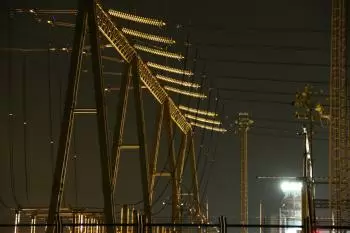
Electricity generation is the process of generating electricity from primary energy sources. The peculiarity of electricity is that it is not primary energy present in nature in significant quantities.
Power generation is the first step in delivering electricity to end-users in the electric power industry. Other steps are transmission, distribution, storage, and power restoration in pumped-storage power plants.
Power plants are facilities designed to produce electricity. Depending on the type of plant, a different energy source is used. For example, many plants use energy to generate steam and drive a turbine connected to an electric generator to transform mechanical energy into electricity.
Depending on the energy resource used, two types of energy production can be classified:
-
Renewable energy sources: they use inexhaustible resources. Most are green energies that do not emit greenhouse gases—for example, solar energy or wind energy.
-
Non-renewable energy sources: they are limited resources that can be depleted. This type includes fossil fuels that emit large quantities harmful to climate change.
Here are some examples of different methods of generating electricity:
1. Fossil fuels and conventional power plants
The most widespread way of generating electricity is by burning fossil fuels (coal, petroleum derivatives, or natural gas). However, this type of fuel is found in a limited way on Earth and, therefore, it is a non-renewable energy source.
Combustion generates heat that is used to heat water and generate steam. The steam drives a steam turbine connected to a generator that produces electricity.
These types of plants developed very quickly during the industrial revolution due to the low fuel cost. However, they generate large amounts of greenhouse gases, and alternatives that do not alter climate change are being sought.
A more sustainable alternative to fossil fuels are biomass plants that obtain heat by burning organic materials.
Combined cycle plants
Combined cycle thermal power plants transform the thermal energy of natural gas into electricity. These power plants work using a gas turbine and a steam turbine.
The process involves the start-up of two consecutive cycles:
-
Brayton cycle, which corresponds to the conventional gas turbine.
-
Rankine cycle, which operates with the steam turbine.
2. Solar power
This type of energy is capable of converting solar radiation into electrical energy. There are two technologies for generating electricity from the Sun:
-
Photovoltaic solar energy: photovoltaic plants are made up of solar panels made up of photovoltaic cells. These photovoltaic modules can convert sunlight into an electrical current.
-
Solar thermal power plants are large installations made up of mirrors that concentrate the radiation at one point. In this way, water is heated to generate steam and drive a steam turbine. The operation is similar to a conventional power plant, but the heat source is solar energy.
Solar thermal systems can be used to produce hot water in small facilities. It is frequent to see solar collectors in houses to supply domestic hot water (DHW) and heating.
3. Nuclear energy and nuclear power plants
Nuclear energy harnesses the heat energy released when an atom is split. It is what we know as a nuclear fission reaction. Nowadays, nuclear power produces about 11% of all electricity in the world.
The principle of generating electricity in nuclear power plants is the same as in conventional thermal power plants. Only in this case, thermal energy is generated in a nuclear reactor.
The fuel for nuclear energy is uranium, which is a mineral that is extracted from the Earth. It is a non-renewable source because natural uranium resources are limited. However, a large amount of power can be obtained with little fuel.
The first nuclear reactor was built in the United States as part of the Manhattan Project in the Second World War context.
It does not emit greenhouse gases but generates radioactive waste that must be treated carefully.
4. Hydraulic power
Hydroelectric power is a sector of renewable energy generation that uses the kinetic energy of flowing water to produce electricity. The energy production companies in this area are hydroelectric plants built on the rivers.
During the construction of a hydroelectric power station with the help of dams on the rivers, a difference in the water surface levels is artificially created. Under the action of gravity, the water moves a turbine connected to a generator.
5. Wind power
Wind energy is a way of harnessing the power of the wind. The wind motion is a consequence of the effect of the Sun, hence we can consider it as a non-conventional energy source.
A wind farm comprises a set of wind turbines that are windmills connected to a generator. Wind turbines generate electricity by converting the wind's kinetic energy into electrical energy.
6. Geothermal energy
Geothermal energy gives the possibility of generating electricity from the heat of the interior of the Earth. It is a clean energy source and it belongs to renewable energy sources.
Geothermal plants are ordinary thermal power plants, in which underground heat sources from the bowels of the Earth are used.
Is a smaller scale, we can use this energy source to take advantage of the heat energy to produce domestic hot water (DHW) and heating energy.